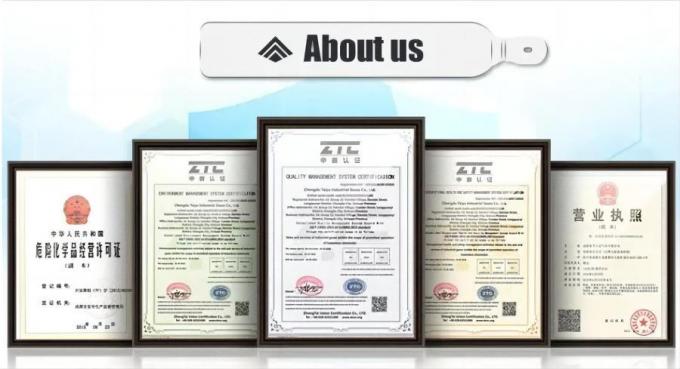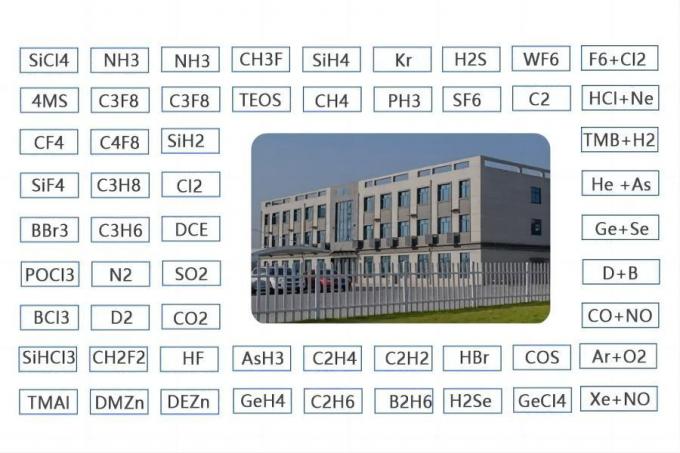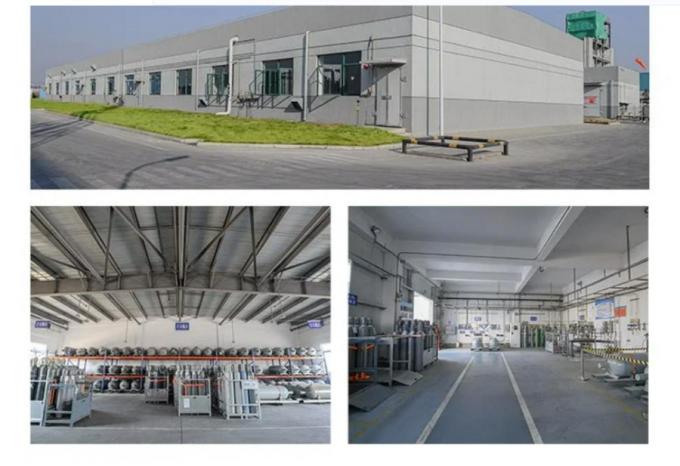


| MOQ: | 1kg |
| Price: | US $500/kg |
| Standard Packaging: | Cylinder/Tank |
| Delivery Period: | 30 days |
| Payment Method: | L/C, T/T |
| Supply Capacity: | 2000 Tons/Year |
Trichlorosilane (HSiCl3) is a chemical compound composed of one silicon atom bonded to three chlorine atoms and one hydrogen atom. It is a colorless, volatile liquid with a pungent odor. Here are some key points about trichlorosilane:
Chemical Composition: Trichlorosilane consists of one silicon (Si) atom bonded to three chlorine (Cl) atoms and one hydrogen (H) atom. Its chemical formula is HSiCl3.
Production: Trichlorosilane is primarily produced through the reaction of metallurgical-grade silicon with hydrogen chloride (HCl) gas:
Si + 3HCl → HSiCl3 + H2
This reaction typically occurs at high temperatures in the presence of a catalyst, such as copper.
Properties: Trichlorosilane is a volatile liquid with a boiling point of -31.8 degrees Celsius (-25.2 degrees Fahrenheit) and a melting point of -132 degrees Celsius (-205.6 degrees Fahrenheit). It has a strong, pungent odor and is highly reactive. Trichlorosilane readily reacts with water or moisture in the air, releasing hydrogen chloride gas and forming silanols (silicon compounds with hydroxyl groups).
Uses: Trichlorosilane has several industrial applications, especially in the production of silicon-based materials:
Silicon Production: Trichlorosilane is a key precursor in the production of polysilicon, which is used to manufacture solar panels, semiconductors, and electronic devices. It is typically used as a feedstock for the chemical vapor deposition (CVD) process, where it is decomposed to deposit silicon layers.
Chemical Synthesis: Trichlorosilane is also used as a starting material or intermediate in the synthesis of various silicon compounds, including silanes and silicones.
Protective Coatings: Trichlorosilane can be used as a protective coating for various surfaces, including metals, glass, and ceramics.
Safety Considerations: Trichlorosilane is toxic and flammable. It is corrosive to the skin, eyes, and respiratory system. It reacts vigorously with water, releasing hydrogen chloride gas, which is highly corrosive and toxic. Proper safety precautions, such as the use of protective equipment and appropriate handling procedures, should be followed when working with trichlorosilane.
Basic Info.
| Model NO. | SiHCl3 | Grade Standard | Electron Grade |
| Transport Package | Canister, Cylinder | Specification | 40L, 200L |
| Trademark | CMC | Origin | Suzhou |
| HS Code | 2812190091 | Production Capacity | 1000t/Year |
Trichlorosilane is a silicon precursor for epitaxial silicon-containing thin films, especially for the
preparation of starting wafers.
Specifications:
| Test items | Unit | Test Result | |
| Components | Purity | % | 99.990 |
| Other CHLOROSILANE | % | 0.010 | |
Impurities |
Co | ppb | 0.01 |
| Cr | ppb | 0.01 | |
| Cu | ppb | 0.01 | |
| Fe | ppb | 0.06 | |
| Mn | ppb | 0.01 | |
| Ni | ppb | 0.01 | |
| V | ppb | 0.01 | |
| B | ppb | 0.01 | |
| Al | ppb | 0.01 | |
| P | ppb | 0.01 | |
| As | ppb | 0.01 | |
| Mo | ppb | 0.01 | |
| Total metal impurities | ppb | <1.00 | |
| P+As | ppb | 0.02 | |
| C | ppm | <0.01 | |
| Gas Density | / | 4.7 | |
![]()




| MOQ: | 1kg |
| Price: | US $500/kg |
| Standard Packaging: | Cylinder/Tank |
| Delivery Period: | 30 days |
| Payment Method: | L/C, T/T |
| Supply Capacity: | 2000 Tons/Year |
Trichlorosilane (HSiCl3) is a chemical compound composed of one silicon atom bonded to three chlorine atoms and one hydrogen atom. It is a colorless, volatile liquid with a pungent odor. Here are some key points about trichlorosilane:
Chemical Composition: Trichlorosilane consists of one silicon (Si) atom bonded to three chlorine (Cl) atoms and one hydrogen (H) atom. Its chemical formula is HSiCl3.
Production: Trichlorosilane is primarily produced through the reaction of metallurgical-grade silicon with hydrogen chloride (HCl) gas:
Si + 3HCl → HSiCl3 + H2
This reaction typically occurs at high temperatures in the presence of a catalyst, such as copper.
Properties: Trichlorosilane is a volatile liquid with a boiling point of -31.8 degrees Celsius (-25.2 degrees Fahrenheit) and a melting point of -132 degrees Celsius (-205.6 degrees Fahrenheit). It has a strong, pungent odor and is highly reactive. Trichlorosilane readily reacts with water or moisture in the air, releasing hydrogen chloride gas and forming silanols (silicon compounds with hydroxyl groups).
Uses: Trichlorosilane has several industrial applications, especially in the production of silicon-based materials:
Silicon Production: Trichlorosilane is a key precursor in the production of polysilicon, which is used to manufacture solar panels, semiconductors, and electronic devices. It is typically used as a feedstock for the chemical vapor deposition (CVD) process, where it is decomposed to deposit silicon layers.
Chemical Synthesis: Trichlorosilane is also used as a starting material or intermediate in the synthesis of various silicon compounds, including silanes and silicones.
Protective Coatings: Trichlorosilane can be used as a protective coating for various surfaces, including metals, glass, and ceramics.
Safety Considerations: Trichlorosilane is toxic and flammable. It is corrosive to the skin, eyes, and respiratory system. It reacts vigorously with water, releasing hydrogen chloride gas, which is highly corrosive and toxic. Proper safety precautions, such as the use of protective equipment and appropriate handling procedures, should be followed when working with trichlorosilane.
Basic Info.
| Model NO. | SiHCl3 | Grade Standard | Electron Grade |
| Transport Package | Canister, Cylinder | Specification | 40L, 200L |
| Trademark | CMC | Origin | Suzhou |
| HS Code | 2812190091 | Production Capacity | 1000t/Year |
Trichlorosilane is a silicon precursor for epitaxial silicon-containing thin films, especially for the
preparation of starting wafers.
Specifications:
| Test items | Unit | Test Result | |
| Components | Purity | % | 99.990 |
| Other CHLOROSILANE | % | 0.010 | |
Impurities |
Co | ppb | 0.01 |
| Cr | ppb | 0.01 | |
| Cu | ppb | 0.01 | |
| Fe | ppb | 0.06 | |
| Mn | ppb | 0.01 | |
| Ni | ppb | 0.01 | |
| V | ppb | 0.01 | |
| B | ppb | 0.01 | |
| Al | ppb | 0.01 | |
| P | ppb | 0.01 | |
| As | ppb | 0.01 | |
| Mo | ppb | 0.01 | |
| Total metal impurities | ppb | <1.00 | |
| P+As | ppb | 0.02 | |
| C | ppm | <0.01 | |
| Gas Density | / | 4.7 | |
![]()


